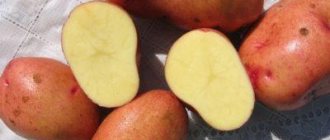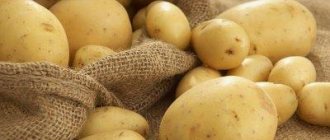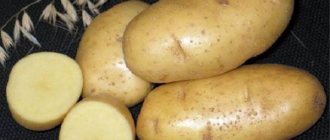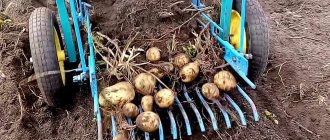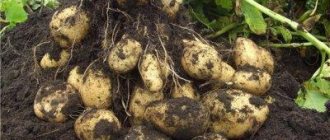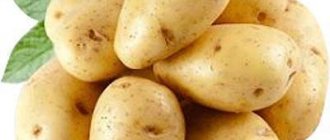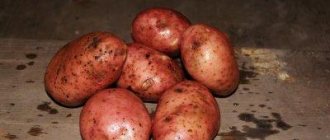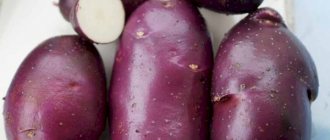Sheri potatoes: variety description
| Variety name | Sheri |
| general characteristics | early ripening table variety, resistant to drought and mechanical damage |
| Maturation period | 70-75 days (the first digging is possible on the 45th day after emergence) |
| Starch content | 10-15% |
| Weight of marketable tubers | 100-160 gr |
| Number of tubers in a bush | 6-10 |
| Productivity | 170-370 c/ha |
| Consumer qualities | good taste, suitable for salads and soups, does not get overcooked |
| Keeping quality | 91% |
| Peel color | red |
| Flesh color | cream |
| Preferred Growing Regions | Central |
| Disease resistance | resistant to golden cyst nematode and potato canker, moderately susceptible to late blight |
| Features of cultivation | the optimal planting depth is 8-10 cm, the distance between rows is 35 cm, between bushes is 60 cm, germination is recommended |
| Originator | Germicopa SA (France) |
Sheri potatoes are early ripening varieties, since the period from germination to technical maturity ranges from 70 to 75 days.
It was included in the State Register of the Russian Federation for the Central region, but became widespread in different countries - Ukraine, Moldova and Israel.
From one hectare of land usually harvests from 170 to 370 centners of such potatoes . Potato variety Sheri is characterized by a delicate and pleasant taste.
When cooked, it does not crumble or become soft, so it is great for making soups and salads. This variety is used for preparing all types of side dishes and serves as a filling for pies, dumplings and rolls. How to keep potatoes peeled and in the refrigerator, read in separate articles on our website.
This vegetable tolerates drought well , and it is better to plant it in soils in which perennial grasses, legumes or winter crops, annual grasses and flax previously grew.
In sandy soils, Cherie potatoes can grow after lupine. It is characterized by resistance to mechanical damage , as well as such dangerous diseases as the causative agent of potato cancer and golden cyst nematode.
As for yield, you can compare this indicator with other varieties in the table below:
| Variety name | Productivity |
| Innovator | 320-330 c/ha |
| Riviera | 450 c/ha |
| Gala | 400 c/ha |
| Picasso | 195-320 c/ha |
| Margarita | 300-400 c/ha |
| Courage | 160-430 c/ha |
| Grenada | 600 c/ha |
| Mozart | 200-330 c/ha |
| Sifra | 180-400 c/ha |
| Elmundo | 250-350 c/ha |
Description and characteristics of the variety
Sheri potatoes belong to the early ripening line - the tubers are dug 70-75 days after the first shoots. The harvest is marketable, with good preservation. It is convenient to use mechanized equipment when digging. But when transporting, you should be careful - you cannot pour it onto something hard or from a great height. During transportation, special container containers are used.
Plants are compact and low. The length of the stems is within 30-40 cm. The leaves are dark, the edges are slightly wavy. The foliage is moderate.
Each potato nest produces up to 10 large tubers, the harvest is uniform and even.
What is useful to know about tubers:
- large size, elongated shape;
- smooth red surface;
- a few eyes;
- starchiness 14-16%;
- average weight 100-160 g;
- the pulp is creamy, dense texture, oily;
- balanced composition.
The tubers have good taste - culinary experts rate 4-4.6 points. They can be prepared in several ways: boiled whole and in slices, baked, prepared from the aromatic pulp as a filling for dumplings and pies. Since the flesh is tender, these potatoes are not recommended for frying or frying.
Origin story
Cheri potatoes belong to a French breeding line. Year of creation - 2007. Potatoes are listed in the State Register of Russia, recommended for temperate latitudes - they are actively cultivated in the Central and Central Black Earth regions.
Characteristics
Sheri potatoes can be recognized by their semi-erect, leafy bushes of medium height. The leaves have a green color and slightly wavy edges.
They can be either intermediate or open type, and their size ranges from medium to large. The corolla is characterized by a red-violet color and small or medium size.
The root crops of this variety of potato are covered with a smooth red skin with small eyes, under which cream-colored flesh is hidden.
They have an elongated shape, and their weight ranges from 98 to 164 grams. The starch content in these vegetables is at the level of 10-15% .
You can compare these indicators with other varieties in the table below:
| Variety name | Average weight of tubers (g) | Starch content (%) |
| Aladdin | 105-185 | until 21 |
| Courage | 100-150 | 13-20 |
| Beauty | 250-300 | 15-19 |
| Mistress | 100-180 | 17-22 |
| Vector | 90-140 | 14-19 |
| Mozart | 100-140 | 14-17 |
| Queen Anne | 80-150 | 12-16 |
| Cast iron | 100-130 | 10-17 |
Mid-early potato varieties
This group includes varieties with an average ripening period of 75 - 85 days. In this category, gardeners prefer varieties such as Gala, Nevsky, Charodey and Adretta.
Gala (Germany)
Productivity of marketable tubers: 400 kg/acre.
Morphology of the bush: medium-sized with large leaves, single white flowers.
Tubers: round with small shallow eyes and yellow veiny skin, bright yellow flesh, average weight 70 - 120 g, 25 pcs per bush.
Taste: good, low starch content, remains dense when cooked, suitable for preparing salads and soups.
Cultivation zones: zoned for the North-Western, Central and Volga-Vyatka regions, universal for cultivation in other regions of Russia.
Features: resistant to nematodes and specific diseases.
Disadvantages: susceptibility to rhizoctonia.
Recommendations for growing: the variety germinates evenly, the bushes form compact, which is convenient for care (weeding, hilling). Ideal for mechanical cleaning. A very unpretentious variety that produces excellent yields when cultivated in dry land. To increase shelf life, it is recommended to mow the tops 2 weeks before harvesting, which will allow the tubers to ripen and stock up on nutrients.
Nevsky (Russia)
Productivity of commercial tubers: 380 - 500 kg/area, maximum - over 600 kg/area, stable.
Morphology of the bush: medium-sized, lush, white flowers.
Tubers: smooth oval with reddish eyes on a smooth white skin, white flesh, average weight 90 - 130 g, 8 - 15 pcs per bush.
Taste: good, starch content below average, peeled tubers do not darken for a long time, and do not become soft when cooked.
Cultivation zones: zoned in all regions of Russia.
Features: high marketability, good shelf life, drought-resistant, resistant to cancer, late blight and rhizoctonia.
Disadvantages: does not tolerate cold weather during planting and harvesting, early germination of tubers.
Recommendations for growing: when planting sprouted tubers, do not allow the sprouts to break off. The variety is responsive to fertilization and watering, so it is suitable for intensive cultivation. It is not recommended to plant in unheated, waterlogged soil.
Charodey (Russia)
The yield of marketable tubers: highly depends on the growing region and ranges from 174 to 370 kg/area, the maximum is 420 kg/area.
Morphology of the bush: erect with light green leaves, white flowers.
Tubers: oval with small inconspicuous eyes on a smooth yellow skin, white flesh, average weight 73 - 116 g, the number of tubers is not constant on different soils.
Taste: good, sweetish; the tubers are easy to peel, do not darken when cooked, but become slightly crumbly; Ideal for making purees.
Cultivation zones: zoned in the Northern, Northwestern, Volga-Vyatka, Central Black Earth, North Caucasus and Middle Volga regions of Russia.
Features: high marketability, high shelf life, drought-resistant, cancer-resistant, average resistance to late blight.
Disadvantages: susceptibility to nematode.
Recommendations for cultivation: mandatory preventive treatments against pests, rare planting scheme.
Adretta (Germany)
Productivity of marketable tubers: 214 - 396 kg/area, maximum - 450 kg/area.
Morphology of the bush: erect, vigorous, white flowers.
Tubers: round-oval with small and sparse eyes on a rough yellow skin, light yellow flesh, average weight 130 g.
Taste: average, softens when cooked; Tubers with a high starch content are suitable for making purees.
Cultivation zones: zoned in the Volga region, Western Siberia and the Far East.
Features: high marketability, good shelf life, high resistance to viral diseases, early formation of tubers.
Disadvantages: none noted.
Recommendations for cultivation: an unpretentious variety to grow, but does not tolerate lack of moisture in the soil and irregular watering.
Features of cultivation
The agricultural technology of this variety is quite standard. Seeds should be buried 8-10 centimeters into the ground. The main measures for caring for these plants are loosening the soil and killing weeds . You can mulch and feed vegetables; during dry periods, watering will not hurt. How and when to apply fertilizers and whether it is worth doing this when planting, read in separate articles.
IMPORTANT! When sowing in open ground, the distance between Sheri potato bushes should be 60 centimeters, and between rows – 35 centimeters.
Advantages and disadvantages
Pros:
- outstanding productivity with proper cultivation (up to 600-700 c per 1 ha);
- large fruit and abundance of tubers in the bushes;
- good internal texture and pleasant taste;
- marketability;
- good preservation;
- drought resistance;
- undemanding to the type of soil;
- tolerance to adverse weather conditions;
- complex immunity.
Minuses:
- risk of skin damage due to careless transportation.
Diseases and pests
The Sheri variety is highly resistant to the most dangerous diseases. However, you can carry out preventative treatments and sprays with fungicidal preparations to protect it from infection. Treatment with insecticidal preparations will help you protect your garden from pest invasion.
Read more about potato diseases in the materials on our website: fusarium wilt, alternaria blight, scab, late blight, verticelliosis.
Fighting the Colorado potato beetle is a process that worries most gardeners. We have prepared a range of materials on this topic for you. Read all about traditional methods of exterminating adults and their larvae, as well as about chemical poisons.
Chemical preparations will help in the fight against the Colorado potato beetle: Aktara, Corado, Regent, Commander, Prestige, Lightning, Tanrek, Apache, Taboo.
The above-mentioned potato variety has proven itself quite well, thanks to the excellent taste of the fruits and their high commercial characteristics .
They can be stored for a long time, so many gardeners grow this variety not only for personal consumption, but also for sale.
Growing and care
The variety tolerates drought well and needs watering 3 times per season: when the tops appear, before flowering and at the height of budding. Moisturizing is carried out in the morning and evening hours. The moisture level per 1 m2 varies from 20 to 40 liters. They use the sprinkling method (the nozzle is attached to a hose and irrigated), and the drip technique.
Fertilizing is carried out in accordance with the algorithm:
| Deadlines | Facilities |
| 2.5-3 weeks after germination | Solution of mullein, litter (dilution 1 to 12) Urea (per 10 l 1 tbsp.) Ash solution (60 g per 10 l) Ammonium nitrate (1 tsp per 6 l) |
| When tying flowers | Superphosphate Potassium chloride Potassium sulfate Speedfall Bor Ohm |
| In the midst of budding | Aquamix Giant Phosphorus-potassium mixtures Speedfol Amino Flowering and Fruiting |
Useful video
Watch the video: weather-resistant potato varieties
We also invite you to familiarize yourself with other potato varieties with different ripening periods:
| Late ripening | Early ripening | Very early |
| Nikulinsky | Bellarosa | Farmer |
| Cardinal | Timo | Jewel |
| Slav | Spring | Kiranda |
| Ivan da Marya | Arosa | Veneta |
| Picasso | Impala | Riviera |
| Kiwi | Zorachka | Karatop |
| Rocco | Colette | Minerva |
| Asterix | Kamensky | Meteor |
Video about the variety "Sheri"
Unfortunately, there is no video for this variety at the moment. We invite you to watch the video section of our website, where other videos about potatoes and other agricultural crops are posted. We and the entire farming community will be grateful if you send us your video or link about this variety from YouTube or any other video hosting service. If you see this message, it means that we have not yet been able to find a suitable video for this variety.
Similar articles:
Potatoes and all their varieties in detail here → Potato variety "Alova" - description characteristics reviews photo video
Potatoes and all its varieties in detail here → Potato variety "Baron" - description characteristics reviews photo video
Potatoes and all their varieties in detail here → Potato variety “Bellaprima” - description characteristics reviews photos video
Potatoes and all their varieties in detail here → Potato variety “Bellarose” - description characteristics reviews photos video
Potatoes and all their varieties in detail here → Potato variety “Bashkir” - description characteristics reviews photos video
Correct fit
Before sowing potatoes, standard pre-sowing measures are carried out:
- Clear the area of weeds or their seeds. For early potato varieties characterized by rapid seedling growth, the absence of competition at the early stage of the growing season is especially important. Two methods of preparing “rested” soil are recommended :
- In autumn, densely sow green manure (mustard, phacelia, alfalfa, clover) on the plot. Before the flowering period, they must be mowed and embedded in the upper layers of the soil. Green manure not only kills weeds, but also improves the quality of the soil. The second method of planting them is before winter. In this case, the plants are not mowed and left until spring, and in the spring the garden is plowed;
- Early application of herbicides to the soil. Means used: Arsenal, Titus, Centurion. They should be applied at least 2 weeks before planting - depending on the chemical properties of the preparations (the timing is precisely indicated in the instructions).
- Seeds are sorted according to the following criteria:
- No damage, cracks or signs of disease;
- Size. One large root vegetable, cut into two parts, is better than two small roots;
- Density. Firm potatoes are preferred;
- Coloring: plain, uniform.
- The tubers are pickled with solutions Agat, Prestige, Tabu. Dressing will protect the seeds from soil pests and stabilize the overall germination of potatoes;
- Loosen the soil by 10 cm;
- Add ash, peat and humus to the planting areas.
TOP5 - ultra early potato varieties:
Planting Density
With the traditional planting method, the distance between planting holes should be 35 cm. The row spacing should be 60 cm.
Late potato varieties
This group includes varieties with a growing season of about 130 days. These varieties, as a rule, are characterized by high yields and good preservation. The Picasso and Zhuravinka varieties deserve the most attention.
Picasso (Netherlands)
Productivity of marketable tubers: 193 - 315 kg/area, maximum - 321 kg/area.
Morphology of the bush: medium height, white flowers.
Tubers: oval with superficial eyes, yellow skin, pinkish in the eye area, cream flesh, average weight 75 - 126 g, 20 pcs per bush.
Taste: good, low starch content, not overcooked.
Cultivation zones: optimally suited for the Moscow region and Central Black Earth Region.
Features: good keeping quality, resistance to cancer and nematodes, attractive appearance of aligned tubers, heat-resistant and drought-resistant.
Disadvantages: marketability is highly dependent on growing conditions, susceptible to late blight.
Recommendations for cultivation: it is advisable to grow using intensive technology with the addition of mineral fertilizers and organic matter. Before planting, it is recommended to germinate the tubers. It is better to plant less frequently, otherwise the tubers will protrude to the surface.
Zhuravinka (Belarus)
Productivity of marketable tubers: 400 - 600 kg/area, maximum - 750 kg/area.
Morphology of the bush: medium-sized, slightly spreading, red-violet flowers.
Tubers: round with shallow eyes, uniform red skin, pale yellow flesh, heterogeneous in weight (about 100 g or more), up to 18 pieces per bush.
Mid-season potato varieties
An intermediate group of varieties with an average ripening period of 100 days. Tuleevsky, Roko and Aurora are in greatest demand.
Tuleevsky (Russia)
Productivity of marketable tubers: 180 - 424 kg/area, maximum - 500 kg/area.
Morphology of the bush: medium height, white flowers.
Tubers: oblong with small eyes, yellow skin with slight roughness, yellow flesh, average weight 122 - 270 g (there are tubers of 500 g each).
Taste: excellent, tubers with medium starch content.
Cultivation zones: zoned in Western and Eastern Siberia and the Far East.
Features: high marketability, good shelf life, scab resistance, weakly affected by late blight.
Disadvantages: susceptibility to nematode.
Recommendations for cultivation: the application of mineral fertilizers and irrigation negatively affect the marketability and safety of root crops during storage.
Rocco (Holland)
Productivity of commercial tubers: 136 - 261 kg/area, maximum - 400 kg/area, stable.
Morphology of the bush: erect, not spreading, red-violet flowers.
Tubers: oval with sparse eyes, red skin, smooth, creamy flesh, average weight 75 - 120 g, 8 - 12 pcs per bush.
Taste: good, medium starch content.
Cultivation zones: zoned in the Middle Volga region.
Features: marketability and shelf life are at an average level, resistance to cancer, late blight and nematodes, resistant to drought, good for processing.
Disadvantages: not the best variety for long-term storage in unequipped cellars.
Recommendations for cultivation: unpretentious, quite hardy to unfavorable soil and climatic conditions.
Aurora (Russia)
Productivity of marketable tubers: 214 - 396 kg/area, maximum - 416 kg/area.
Morphology of the bush: tall, with large leaves, purple flowers.
Tubers: oval with superficial eyes, beige skin, reddish in the eye area, creamy flesh, average weight 93 - 128 g, 20 - 25 pcs per bush. (according to some reviews, in some years this figure is closer to 40).
Taste: excellent, high starch content, crumbly.
Cultivation zones: zoned in the Northern, Northwestern and Central regions.
Features: high marketability, average shelf life, resistance to cancer and nematode, high drought resistance.
Disadvantages: a high level of agricultural technology is required.
Recommendations for growing: tall stems need regular hilling so that the bush does not fall apart. Fertilizing significantly increases productivity.
